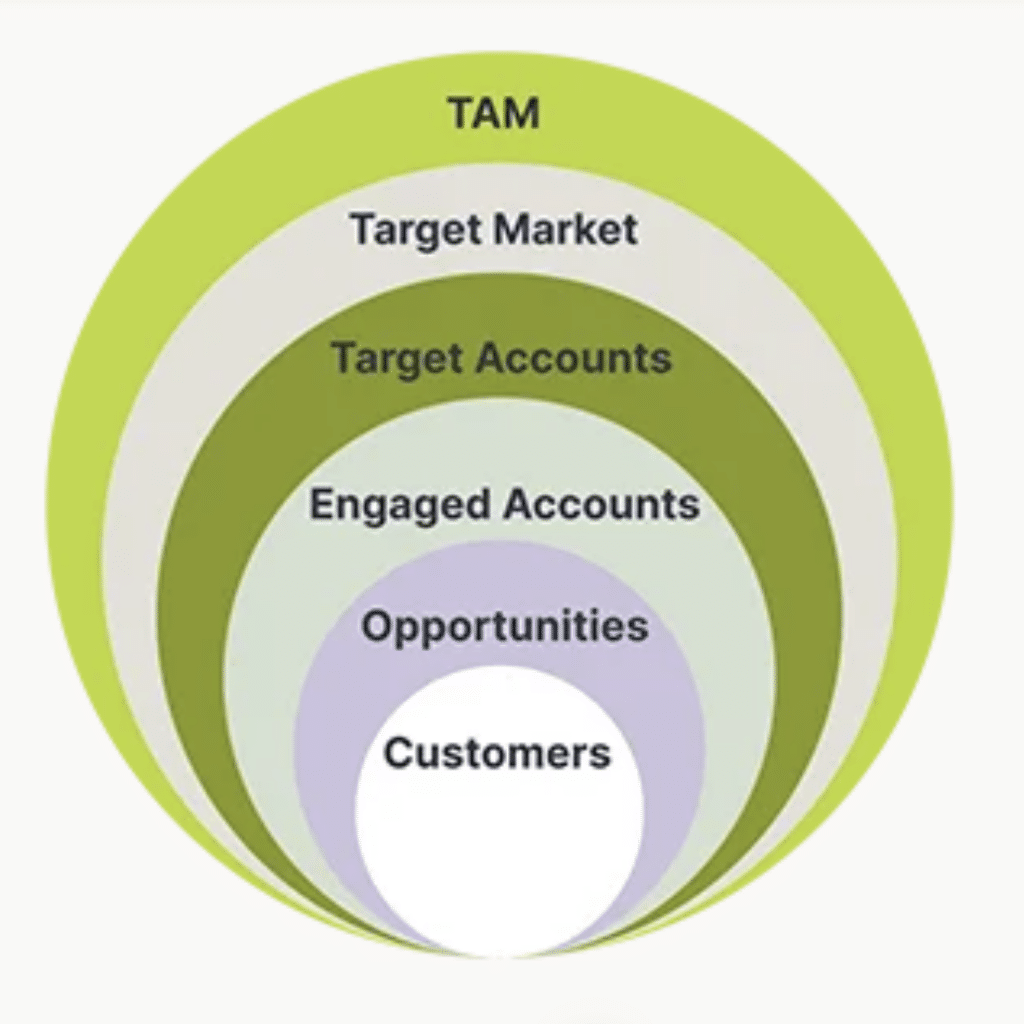There's a much easier way to improve the chances of success with your account-based marketing (ABM) campaigns – and that’s by employing B2B market segmentation during the planning stages.
Segmentation empowers you to tailor your marketing campaigns, resonate with key accounts, and drive meaningful connection with customers.
In this guide, we'll make a case for why B2B market segmentation should be an ABM best practice. Along the way, we'll define segmentation methods and address common challenges marketers face when looking to take advantage of this strategy with their ABM program.
What is B2B Market Segmentation?
B2B marketing segmentation takes a large market, or your total addressable market (TAM), and makes it smaller, into more manageable pieces, or segments. This allows for tailored messaging and targeted campaigns.
There are several types of market segmentation you can use, but the most common way to section your TAM in B2B is through firmographics (company size, industry, and profit). You can also use technology data, buyer journey data, and behavioural data as well.
Importance of B2B Market Segmentation in ABM
B2b marketing segmentation can be the difference between closing or missing out on the sale. Instead of keeping your fingers crossed for results, segmentation gives you the ability to send highly targeted communications to potential customers. You’ll see benefits like:
- Increased Revenue: B2B segmentation boosts conversion rates and annual revenue by targeting high-potential accounts with super personalized messaging.
- Reduced Marketing Costs: Segmenting your target market allows you to allocate resources more efficiently. By focusing efforts on accounts that align with your ideal customer profile, you can save on marketing dollars get a higher ROI.
- Personalized Buying Journey: ABM gives personalized experiences to key accounts. Marketers can craft relevant content and interactions that resonate with individual target companies' specific needs, audience pain points, and preferences.
- Improved Prospect Experience: By understanding the unique needs of the different segments within your target market, you can deliver customers a more personalized and engaging experience. You’ll improve relationships, build trust, and ultimately get customers to convert.
Types of B2B Market Segmentation and How to Apply Them to ABM
Okay wow, sounds great! But what does segmentation look like in practice? There’s a few different ways to segment a TAM into manageable bite sized chunks. Let's take a look at these segmentation methods and their application in ABM strategy:
Firmographic Market Segmentation
Firmographic segmentation is when you categorize companies based on shared attributes such as industry, company size, revenue, location, number of employees, and organizational structure.
ABM Application: Marketers can use firmographic data to identify high-value accounts that align with their ideal customer profile (ICP). By understanding these companies' specific demographics and characteristics, ABM managers can create targeted messaging and personalized marketing campaigns that speak to their clients exact needs and challenges.
Behavioural Market Segmentation
Behavioural segmentation focuses on analyzing potential buyers' actions, behaviours, and interactions.
ABM Application: Marketers can track and analyze the online behaviour, intent data, customer needs, engagement patterns, and content consumption habits of target accounts to gain insights into their interests, preferences, and purchasing intent.
By understanding how target accounts interact with their brand and content, ABM managers can effectively tailor their outreach efforts and content strategy to engage and nurture these accounts throughout their buying journey.
Tiered Market Segmentation
Tiered segmentation is when you categorize accounts into different tiers or priority levels based on their value, potential, or fit with the company's objectives.
ABM Application: Marketers can use tiered segmentation to prioritize their resources and efforts, focusing on high-value accounts with the most significant revenue generation or strategic alignment potential. By allocating resources more strategically and tailoring their approach to each tier's specific needs and priorities, ABM managers can maximize their impact and ROI.
Customer Sophistication Market Segmentation
Customer sophistication segmentation categorizes accounts based on their level of knowledge, awareness, and sophistication regarding the products or solutions offered.
ABM Application: Marketers can tailor their messaging and content strategy to align with different target accounts' varying levels of sophistication. By delivering content and messaging matching each account's knowledge level and awareness stage, ABM practitioners can effectively educate, engage, and influence prospects throughout their buying journey.
Needs-based Market Segmentation
Needs-based segmentation involves identifying and categorizing accounts based on their specific needs, pain points, and challenges.
ABM Application: Marketers can use needs-based segmentation to personalize their messaging and offerings to address the unique needs of different target accounts. By understanding each account's specific pain points and challenges, ABM managers can position their products or solutions as tailored solutions that directly address their needs and deliver tangible value.
Buyer Journey-based Market Segmentation
Buyer journey-based segmentation focuses on mapping the different stages of the buying journey and tailoring marketing efforts to align with each stage.
ABM Application: Marketers can use buyer journey-based segmentation to deliver targeted content and messaging that guides prospects through each stage of the buying process. By providing relevant information and resources at each touchpoint, ABM managers can nurture prospects and push their progression through the funnel, ultimately driving conversion and revenue.
How to Segment Your B2B Market
Here’s how you segment your B2B market for maximum impact:
Narrow Down Your Total Addressable Market (TAM) into Your Target Market
To narrow your TAM into your target market, analyze your ideal customer profile (ICP). Identify key criteria such as industry, company size, revenue, geographic location, and other relevant demographics. Next, use data analytics and market research to filter your TAM based on these criteria, focusing on accounts that closely match your ICP.
Best Practices:
- Continuously refine your ICP based on feedback and insights from sales and marketing teams.
- Utilize data enrichment tools to gather additional information about target accounts and validate their fit.
- Regularly revisit and update your TAM to ensure alignment with evolving business objectives and market dynamics.
Identify Your Target Account List
Once you've narrowed your TAM, it's time to identify your target account list. This is when you select a customer base representing your business's highest value and strategic importance. Use a combination of data-driven insights, predictive analytics, and behaviour-based targeting to identify buyer personas with common characteristics with the most significant potential for profitability and alignment with your objectives.
Best Practices:
- Collaborate closely with sales teams to align on criteria for defining target accounts and prioritize based on sales-readiness.
- Leverage predictive analytics tools to identify accounts exhibiting buying signals and propensity to engage.
- Use behaviour-based targeting tools to track and analyze target accounts' online interactions and engagement patterns, enabling a more precise targeting and personalized customer experience.
Segment and Pick Your Priority Audiences
Once you have identified your potential customers, segment them into priority audiences based on factors such as buying stage, level of engagement, or strategic importance. Tailor your messaging and outreach strategies to address each segment's specific needs and priorities, ensuring maximum relevance and impact.
Best Practices:
- Use market segmentation software that enables you to segment target accounts based on industry vertical, geographic region, decision-making authority, or purchase intent.
- Customize messaging and content for each audience segment, highlighting unique value propositions and addressing specific pain points.
- Continuously monitor and analyze the performance of different audience segments, refining your segmentation strategies based on insights and feedback.

B2B Market Segmentation Challenges and How to Avoid Them
B2B marketing segmentation comes with its own set of challenges. Let's get into some common challenges and explore ways to avoid them:
B2B Buyers are More “Rational”
B2B buyers tend to make purchasing decisions based on logical reasoning and business needs rather than emotional factors.
In B2B transactions, buyers are often accountable to stakeholders and must justify their decisions based on ROI, efficiency gains, and alignment with strategic objectives.
To address this challenge, marketers should focus on providing evidence-based value propositions, quantifiable ROI metrics, and case studies showcasing successful outcomes. Highlighting tangible benefits and addressing potential objections through data-driven insights can help build credibility and trust with rational B2B buyers.
The B2B Buying Journey Involves Multiple Decision Makers
Unlike consumer purchases, B2B buying decisions typically involve multiple stakeholders across various departments or levels of the organization.
Each stakeholder may have different priorities, concerns, and decision-making criteria, leading to complexity and potential conflicts during the buying process.
To navigate the complexity of the B2B buying journey, marketers should focus on building consensus among stakeholders by aligning messaging and content with each decision-maker's diverse needs and interests. Collaborating closely with sales teams and using account-based marketing (ABM) strategies can help identify key influencers and tailor communication to address their specific concerns.
The Purchasing Criteria for B2B Products can be Complex
B2B purchasing decisions often involve evaluating complex products or solutions with multiple features, specifications, and technical requirements.
When evaluating potential solutions, B2b businesses must consider factors such as functionality, scalability, integration capabilities, vendor reputation, and long-term support.
To simplify the process for B2B purchases, marketers should focus on providing clear, concise messaging highlighting the most relevant features and benefits of their offerings. Educational resources like white papers, webinars, and product demonstrations can help buyers better understand the potential value and make informed decisions. Customer testimonials and case studies can also provide social proof and calm concerns about product complexity.
It can be Challenging Mapping Need-based and Behavioural Segments in B2B Markets
Identifying and mapping need-based and behavioural segments in B2B markets requires granular data and sophisticated analytics tools.
B2B buyers may show complex behaviours and preferences influenced by industry trends, organizational dynamics, and individual preferences.
To overcome these ABM mistakes, marketers should invest in advanced data analytics and segmentation tools to gather and analyze customer data effectively. Machine learning algorithms and predictive analytics can help identify patterns and trends within customer behavior, allowing for more accurate segmentation and targeting.
Additionally, regular market research and customer surveys can provide valuable insights into evolving needs and preferences, allowing marketers to adapt their segmentation strategies accordingly.
Here's What B2B Market Segmentation Can Do For You!
When you accurately segment down your market, you can expect to see big results. According to a study by Mailchimp, segmented emails have a 14.31% higher open rate, an unsubscribe rate that is 9.37% lower, and 2X the clicks!
That personalized engagement is crucial for potential clients feeling like “people”, and not just another account, in ABM campaigns. From firmographic insights to behavioural analysis, mastering segmentation can deepen the connection to your target audience. When you use data-driven strategies, you’ll overcome the hurdles typically seen in B2B marketing.
Ready to grow? Subscribe to The CMO newsletter to stay on top of trends and get the latest tips, resources, and guides from our community of seasoned marketing leaders straight to your inbox.


